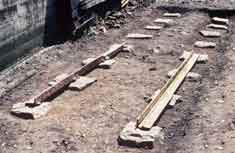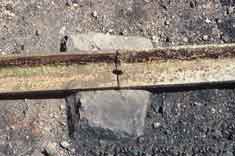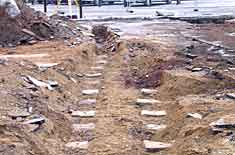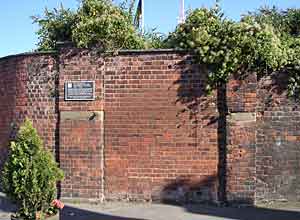An early type of
railway for horse-drawn wagons was opened between Gloucester and
Cheltenham in 1811, the main purpose being to facilitate the carriage
of coal to Cheltenham. It was eventually superceded by the Midland
Railway Company's lines worked by steam locomotives, and the cast-iron
rails were taken up in 1861. This page outlines the history of the
line and describes what remains today.
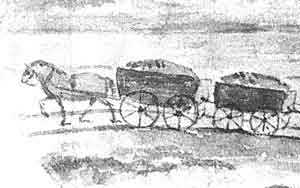 Permanent
Way Permanent
Way
The line to Cheltenham
had a single track with passing places. Stone sleeper blocks supported
cast-iron rails that were 3ft long and L-shaped in section to suit
wagon wheels without flanges. Any trader could put his own wagons
and horses on the track provided he paid the appropriate toll. This
type of line is now known as a tramroad to distinguish it from the
later main-line railways having flanged wheels running on edge rails.
Early Operation
The
opening of the tramroad in 1811 induced the Canal Company to allow
the basin at Gloucester to be used for the discharge of river-borne
cargoes even though the rest of the canal was very far from completion.
Over the following years a network of sidings was laid down around
the basin to handle the trade that developed, boosted by the eventual
opening of the canal in 1827. Most of the traffic was concerned
with taking coal to Cheltenham, but road stone and other heavy goods
were also carried. For further information about the operation of
the tramroad, including the trial use of a steam locomotive, see
The Gloucester and Cheltenham Tramroad by David Bick (from
which the above illustration is taken).
Later Operation
In 1840,
a main line railway was opened between Gloucester and Cheltenham,
as part of the line to Birmingham, but initially there was no connection
to the docks. The tramroad therefore took on a new role of carrying
goods between the docks and Gloucester station, and so for a few
years it became an important link in a new route for forwarding
imports to the Midlands in competition with the existing river and
canal route. This additional role ended in 1848 when a branch from
the main line into the docks was opened, but the tramroad continued
to provide a local service for several more years. This role gradually
declined, however, and in 1861 the line was closed and the rails
were taken up.
Surviving Stone Blocks
Although
the rails were taken up, many of the stone sleeper blocks were left
in situ at that time, and some were discovered still undisturbed
during an archaeological excavation in 1983 - see pictures below.
For a full report of the excavation, see GSIA Journal for
1983. The stones were subsequently covered over to allow the area
to be used as a car park, and they were revealed again during preparations
for building a block of apartments on the site. |
 Permanent
Way
Permanent
Way